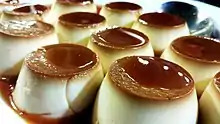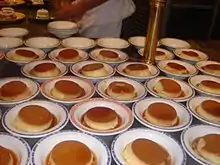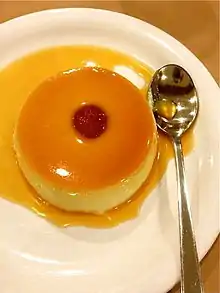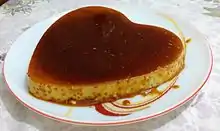Crème caramel
Crème caramel (French: [kʁɛm kaʁaˈmɛl]), flan, or caramel custard is a custard dessert with a layer of clear caramel sauce, contrasted with crème brûlée which is custard with a hard caramel layer on top.
 A row of crèmes caramel | |
| Alternative names | Flan, caramel custard |
|---|---|
| Course | Dessert |
| Place of origin | Spain, France, Italy and Portugal |
| Serving temperature | Cold or warm |
| Main ingredients | Eggs, milk, sugar |
| Variations | Crème brûlée, crema catalana |
History
Crème caramel used to be ubiquitous in European restaurants; food historian Alan Davidson remarks:
In the later part of the 20th century crème caramel occupied an excessively large amount of territory in European restaurant dessert menus. This was probably due to the convenience, for restaurateurs, of being able to prepare a lot in advance and keep them until needed.[1]
Etymology of names
In this context, crème in French means 'custard'. The names crème (caramel) renversée (French) and crema volteada (Spanish) allude to the custard being turned over to be served.

Both crème caramel ("caramel cream") and flan are French names, but flan has come to have different meanings in different regions.
In Spanish-speaking countries and often in the United States, crème caramel is known as flan. This was originally a Spanish-language usage, but the dish is now best known in North America in a Latin American context. Elsewhere, including in Britain, a flan is a type of tart somewhat like a quiche.
The Modern English word flan comes from French flan, from Old French flaon, in turn from Medieval Latin fladonem, derived from the Old High German flado, a sort of flat cake, probably from an Indo-European root for 'flat' or 'broad'.[2]
Preparation, cooking and presentation

Preparation
Crème caramel is a variant of plain custard (crème) where sugar syrup cooked to caramel stage is poured into the mold before adding the custard base. It is usually cooked in a bain-marie on a stovetop or in the oven in a water bath. It is turned and served with the caramel sauce on top, hence the alternate French names crème (caramel) renversée or crème renversée au caramel. The milk may be flavored with vanilla, cinnamon, or lemon peel.
The resulting texture is gelatinous and creamy.
Turning out larger dishes requires care, as the custard easily splits. Larger dishes also require more care to avoid undercooking the interior or overcooking the exterior. Thus, crème caramel is often cooked and served in individual ramekins. The objective is to obtain a homogeneous and smooth cream on the surface of the crème caramel with a liquid caramel base. Cooking it in a bain-marie avoids burning the caramel.
Imitations
An imitation of crème caramel may be prepared from "instant flan powder", which is thickened with agar or carrageenan rather than eggs. In some Latin American countries, the true custard version is known as "milk flan" (flan de leche) or even "milk cheese", and the substitute version is known as just "flan".
Regional varieties

Croatia

In Croatia, rožata, rozata, rožada or rozada (pronounced [rǒʒaːta]) is flavored with the Dubrovnik liqueur rozalin (rose liqueur), which gives the cake its characteristic aroma. Modern variations include vanilla and other flavorings.[3]
India

Caramel custard is popular, especially in the larger coastal cities, and in former Portuguese colonies such as Goa, Daman and Diu. Sometimes, masala chai is added on the side. It is a staple on restaurant menus in the beach resorts along India's coasts and also prepared regularly in the home kitchens of the Anglo-Indian Goan, Malayali, Mangalorean and Parsi communities.
Japan
Packaged crème caramel is ubiquitous in Japanese convenience stores under the name purin (プリン) (i.e., "pudding"), or custard pudding. The same kind of dessert are sold in convenience stores in Taiwan.
Malaysia
Caramel custard is a very popular dessert in Malaysia. First introduced by the Portuguese in the 16th century and sold year-round today, this dessert is popular served in restaurants, cafes, hotels and even Ramadan bazaars for breaking the fast.
Philippines

In the Philippines, flan is known as leche flan (the local term for the originally Spanish flan de leche, literally "milk flan"), which is a heavier version of the Spanish dish, made with condensed milk and more egg yolks. Leche flan is usually steamed over an open flame or stove top in an oval-shaped tin mold known as llanera (also spelled lyanera), although rarely it can also be baked. Leche flan is a staple dessert in celebratory feasts.[4][5]
An even heavier version, called tocino de cielo or tocino del cielo (Spanish for "heaven's bacon"), is similar, but has significantly more egg yolks and sugar.[6]
Leche flan is also commonly baked into pastries. The most common is the Filipino dessert flan cake or leche flan cake, a Filipino chiffon or sponge cake with a layer of leche flan on top.[7][8][9] It can similarly be baked into steamed cupcakes known as puto mamón, a combination known as puto flan.[10]
Vietnam
Crème caramel was introduced by the French and is common in Vietnam. It is known as bánh caramel, caramen or kem caramel in northern Vietnam or bánh flan or kem flan in southern Vietnam. Variations include serving with black coffee poured on top, or browning the caramel past typical caramelization point to make a darker, more bitter "burnt caramel".
Spain, Portugal and Latin America

Most notably in Argentina, Chile, Peru and Uruguay, crème caramel is usually eaten with dulce de leche, whipped cream, or both (flan mixto). In Chile, it is often eaten with dulce de membrillo (quince jelly) or condensed milk. Also at most equatorial and Caribbean countries the inclusion of coconut, condensed milk and evaporated milk is widespread.
The milk base may also be flavored with nuts, fruit, and so on.
Spain
In Spain, most varieties of flan are available although the most well known one is known as flan de huevo. Other varieties include turron - Spain's almond nougat.
Portugal

Known as Pudim flan, made with milk, eggs, caramelized sugar and vanilla. Variations include orange or lemon zest, cinnamon, pineapple, Port wine or even bacon as its the case with Pudim Abade de Priscos. It characteristically has a hole in the center.
Puerto Rico
Most Puerto Rican flans are based on eggs and milk. Egg white and egg yolks are beaten separately with sugar to achieve a light flan.
Flan de coco is made with condensed milk, coconut cream, and evaporated milk. Some coconut flans replace milk with coconut milk or other fruit purées, juices or plant-based milks.
On Thanksgiving, it is popular to add pumpkin, sweet potato, or ñame purée along with spices like ginger, vanilla, cinnamon to the flan. A combination of pumpkin, coconut milk, batata, carrot and almond extract flan is only served on Thanksgiving.
Flancocho, or flan cake, is a vanilla, almond, or yellow cake batter mixed with cream cheese flan. This results in flan on top, with caramel and sponge cake underneath.
Piña colada flan is very popular. It includes eggs, cream of coconut, pineapple juice, heavy cream, rum, and bitters. The caramel is cooked with lime juice and maraschino cherry liquid.
Coffee, cream cheese and hazelnut milk flan is served during the holidays with coquito (Puerto Rican eggnog), often with chocolate, cinnamon, and vanilla.
Popular flavors are cream cheese, chocolate, mango, pineapple, lemon, lime, guava, passion fruit, and tamarind.
Spanish lime, sweet plantains, sesame seed milk, breadfruit and cassava are also uniquely Puerto Rican.
Brazil and Venezuela
In Venezuela and Brazil, it is often made with condensed milk, milk, eggs and sugar caramelized on top. The Venezuelan version is known as quesillo ("small cheese") and in Brazil, it is known as pudim ("pudding"). It can have variations of flavor, such as chocolate, coconut, paçoca (peanut candy), cheese and others, being the condensed milk pudding a base recipe.
Costa Rica
Flan in Costa Rica often features coconut or coffee (flan de café).
Cuba
Cuban flan (flan de Cuba) is made with the addition of the whites of two eggs and a cinnamon stick. A similar Cuban dish is Copa Lolita, a small caramel flan served with one or two scoops of vanilla ice cream. Other variations include coconut or rum raisin topping.
Dominican Republic
In the Dominican Republic, only egg yolks are used, mixed with vanilla, evaporated milk and condensed milk. Coconut flan is known as quesillo.
Mexico
Flan is extremely popular in Mexico, being made at home, found pre-made at grocery stores, served in restaurants, and even vended on the streets. A variation of the dish called Flan Napolitano is made in some parts of Mexico where cream cheese is added to create a creamier consistency, though it is not as popular or wide spread. Flan's popularity among Mexican-Americans helped the dish become popular in the United States. Another variation is "Flan de Cajeta" which replaces the standard caramel with cajeta (Milk caramel with a base of goat Milk)
See also
- Crème brûlée
- Pudim Abade de Priscos, a rich Portuguese variant
- Rožata
- Leche asada
Notes
- Davidson, s.v. crème caramel
- Oxford English Dictionary, 2nd Edition (1989); Petit Robert 1973.
- "Traditional Cuisine of the Makarska Littoral"
- "Leche Flan". Kawaling Pinoy. Retrieved 14 March 2019.
- "Leche Flan Molder". Tagalog Lang. Retrieved 14 March 2019.
- "Tocino Del Cielo Recipe". Yummy.ph. Retrieved 14 March 2019.
- "Filipino Custard Cake plus Video". The Skinny Pot. Retrieved 28 June 2019.
- "Leche Flan Cake / Creme Caramel Cake". The Culinary Corner. Retrieved 28 June 2019.
- "Leche Flan Caramel Custard Chiffon Cake". SugaryWinzy. Retrieved 28 June 2019.
- "Leche Puto". Kawaling Pinoy. Retrieved 28 June 2019.
- Gastón Acurio (2008). Larousse de la gastronomía peruana: diccionario gatronómico ilustrado. Q.W. Editores. p. 151. ISBN 978-9972-58-937-9.
- Morena Cuadra; Morena Escardó (5 February 2019). The Big Peruvian Cookbook: 100 Delicious Traditional Recipes from Peru. Skyhorse. p. 355. ISBN 978-1-5107-3786-0.
- María Luisa B. de Sanguineti (1950). Recetas económicas y prácticas de cocina y reposteria. p. 55.
- Julia García; Gabriela González de Castejón (1 January 2004). Perú: historia, política, sociedad, economía, cultura. Biblioteca Nueva. p. 128. ISBN 978-84-9742-323-6.
- "The Epic Food and Landscape of Patagonia". Saveur. Retrieved 2020-07-21.
- "Leche asada". www.solopostres.com. Retrieved 2020-07-21.
References
| Wikimedia Commons has media related to Flan. |
| Look up Crème caramel in Wiktionary, the free dictionary. |
- Alan Davidson, The Oxford Companion to Food, 1999. ISBN 0-19-211579-0.
